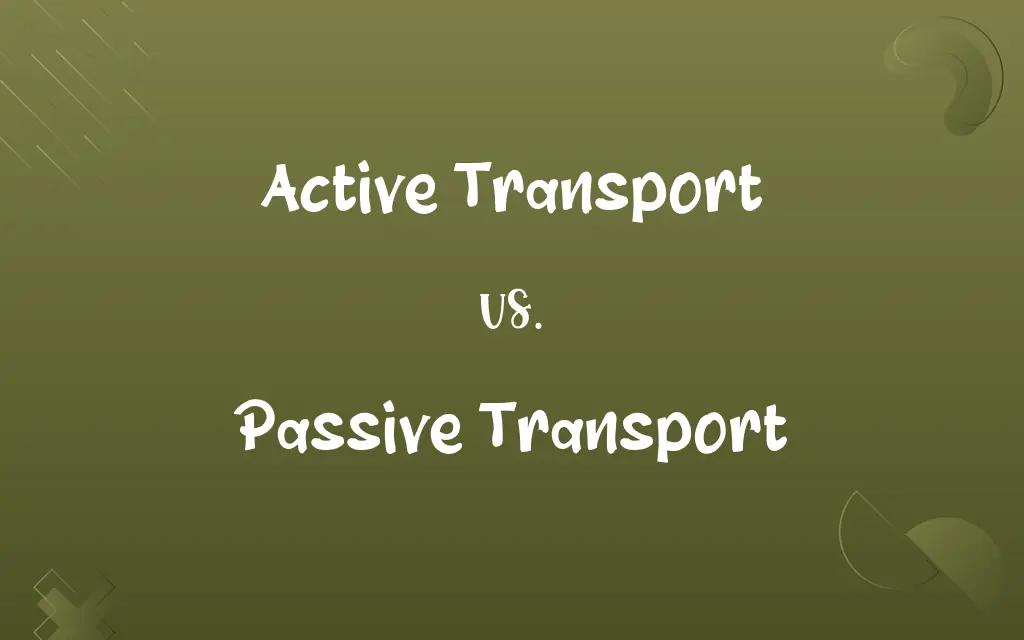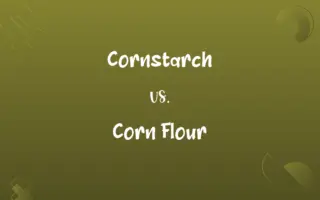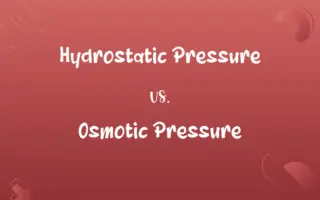Active Transport vs. Passive Transport: Know the Difference

By Shumaila Saeed || Updated on December 25, 2023
Active transport requires energy to move substances across cell membranes against a concentration gradient, while passive transport does not require energy, moving substances along the gradient.

Key Differences
Active transport requires cellular energy (usually ATP) to move molecules against their concentration gradient. In contrast, passive transport relies on the natural movement of molecules down their concentration gradient, requiring no energy.
Shumaila Saeed
Dec 10, 2023
In active transport, substances move from areas of lower concentration to higher concentration, which is against the natural flow. Passive transport moves substances from areas of higher to lower concentration, following the natural flow.
Shumaila Saeed
Dec 10, 2023
Active transport is often used for ions, glucose, and other substances that need to be concentrated in a specific area. Passive transport typically involves small, nonpolar molecules like oxygen and carbon dioxide.
Shumaila Saeed
Dec 10, 2023
Active transport often involves specific transport proteins, such as pumps, that facilitate the movement of molecules. Passive transport can occur through diffusion or facilitated diffusion, which may or may not involve transport proteins.
Shumaila Saeed
Dec 10, 2023
Active transport plays a crucial role in maintaining cellular homeostasis by controlling the internal concentration of various ions and molecules. Passive transport assists in balancing concentrations but does not require direct energy input.
Shumaila Saeed
Dec 10, 2023
ADVERTISEMENT
Comparison Chart
Concentration Gradient
Against gradient (low to high)
Along gradient (high to low)
Shumaila Saeed
Dec 10, 2023
Transport Proteins
Uses pumps and other specific proteins
May or may not use transport proteins
Shumaila Saeed
Dec 10, 2023
Role in Homeostasis
Crucial for maintaining concentration
Balances concentration passively
Shumaila Saeed
Dec 10, 2023
ADVERTISEMENT
Active Transport and Passive Transport Definitions
Active Transport
Movement of substances against a concentration gradient using energy.
Sodium-potassium pumps in nerve cells use active transport to maintain ion gradients.
Shumaila Saeed
Dec 03, 2023
Passive Transport
Simple diffusion or facilitated diffusion without ATP.
Nutrients diffuse into cells through passive transport.
Shumaila Saeed
Dec 03, 2023
Active Transport
Cellular process requiring ATP to transport molecules.
Active transport is essential for absorbing glucose in the intestines.
Shumaila Saeed
Dec 03, 2023
Passive Transport
Natural movement of molecules from high to low concentration.
Carbon dioxide is expelled from cells via passive transport.
Shumaila Saeed
Dec 03, 2023
Active Transport
Transport of molecules from lower to higher concentration.
Active transport in kidneys reabsorbs vital substances from urine.
Shumaila Saeed
Dec 03, 2023
ADVERTISEMENT
Passive Transport
Transport of small molecules without using cellular energy.
Water moves into cells by passive transport.
Shumaila Saeed
Dec 03, 2023
Active Transport
Use of cellular energy to move substances across membranes.
Cells use active transport to accumulate amino acids from their environment.
Shumaila Saeed
Dec 03, 2023
Passive Transport
Non-energy-requiring movement through cell membranes.
Passive transport is responsible for the diffusion of ions across neuron membranes.
Shumaila Saeed
Dec 03, 2023
Active Transport
Energy-driven movement of particles through cell membranes.
Active transport helps root cells in plants absorb nutrients from the soil.
Shumaila Saeed
Dec 03, 2023
Passive Transport
Movement of substances down a concentration gradient without energy.
Oxygen enters cells through passive transport.
Shumaila Saeed
Dec 03, 2023
Repeatedly Asked Queries
What is passive transport?
It's the movement of substances along their concentration gradient without energy.
Shumaila Saeed
Dec 10, 2023
What is active transport?
It's the movement of substances against their concentration gradient using energy.
Shumaila Saeed
Dec 10, 2023
Does active transport require cellular energy?
Yes, it typically uses ATP as an energy source.
Shumaila Saeed
Dec 10, 2023
Can passive transport move molecules against the gradient?
No, it only moves molecules along the gradient.
Shumaila Saeed
Dec 10, 2023
Why is active transport important for cells?
It's crucial for maintaining concentration gradients essential for cell functions.
Shumaila Saeed
Dec 10, 2023
What are examples of active transport?
Sodium-potassium pumps and glucose absorption in intestines.
Shumaila Saeed
Dec 10, 2023
Can passive transport occur in dead cells?
Yes, as it doesn't require cellular energy or living processes.
Shumaila Saeed
Dec 10, 2023
What factors influence passive transport?
Concentration gradients, temperature, and the permeability of the cell membrane.
Shumaila Saeed
Dec 10, 2023
How does passive transport maintain homeostasis?
By balancing the concentrations of substances inside and outside the cell.
Shumaila Saeed
Dec 10, 2023
What role do proteins play in active transport?
Proteins like pumps help move substances against the gradient.
Shumaila Saeed
Dec 10, 2023
How do cells regulate active transport?
Through the availability of ATP and the regulation of transport proteins.
Shumaila Saeed
Dec 10, 2023
Can active transport be inhibited?
Yes, by factors that affect energy production or protein function.
Shumaila Saeed
Dec 10, 2023
What are examples of passive transport?
Oxygen entering cells and carbon dioxide leaving cells.
Shumaila Saeed
Dec 10, 2023
What's the role of ATP in active transport?
ATP provides the necessary energy to move substances against their gradient.
Shumaila Saeed
Dec 10, 2023
Can active transport create concentration imbalances?
Yes, it's often used to create or maintain specific concentration imbalances.
Shumaila Saeed
Dec 10, 2023
Is facilitated diffusion a form of passive transport?
Yes, it's passive transport through specific transport proteins.
Shumaila Saeed
Dec 10, 2023
Is osmosis a type of passive transport?
Yes, it's the passive movement of water across a semipermeable membrane.
Shumaila Saeed
Dec 10, 2023
How does temperature affect passive transport?
Higher temperatures generally increase the rate of passive transport.
Shumaila Saeed
Dec 10, 2023
Do all forms of passive transport use transport proteins?
Not all; some substances diffuse directly through the lipid bilayer.
Shumaila Saeed
Dec 10, 2023
Is active transport faster than passive transport?
Not necessarily; its speed depends on the availability of energy and transport proteins.
Shumaila Saeed
Dec 10, 2023
Share this page
Link for your blog / website
HTML
Link to share via messenger
About Author
Written by
Shumaila SaeedShumaila Saeed, an expert content creator with 6 years of experience, specializes in distilling complex topics into easily digestible comparisons, shining a light on the nuances that both inform and educate readers with clarity and accuracy.








































































